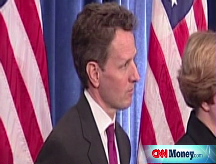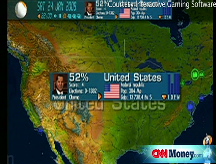First 100 days: Obama's burden
The new president will have to spur initiatives across the entire economic landscape.
NEW YORK (CNNMoney.com) -- The scope and intensity of problems facing President Obama are similar only to those that Franklin D. Roosevelt faced in 1933.
Roosevelt in his first 100 days pushed through 15 pieces of legislation that transformed financial regulation and created a social safety net that has endured.
Obama won't get that many bills passed.
But he will make decisions and implement policy changes between now and April 29 that will not only color the rest of his presidency but likely those of his successors for years to come.
Here are six issues on the economy that Obama and his team will have to tackle in their first 100 days at the White House.
Topping Obama's economic to-do list will be getting an economic stimulus bill through Congress.
Obama has gone out of his way to tamp down expectations. He's noted in several speeches that the economy will likely get worse before it gets better. And even his top economic advisers say that the best his proposals (most of which are included in the House Democrats' $825 billion stimulus bill) can do is to create or save between 3 million and 4 million jobs. That's enough to keep the unemployment rate from getting worse by 2010, they estimate, but not enough to actually reduce it from where it is today, at 7%.
Lawmakers last week gave Obama $350 billion to work with - and his first legislative victory before even taking office - when they voted to allow the Treasury to access the second half of the $700 billion Troubled Asset Relief Program. But they also made it clear they expect some of that money to be used to prevent foreclosures.
In a letter to Democratic leaders in the House and Senate, top Obama economic aide Larry Summers promised that the administration would commit between $50 billion to $100 billion "to a sweeping effort to address the foreclosure crisis." He said the new administration would implement policies to "reduce the number of preventable foreclosures by helping to reduce mortgage payments for economically stressed but responsible homeowners."
The Obama team has promised lawmakers new and improved efforts to stabilize the financial system. Call it TARP 2.0.
Obama and his advisers have vowed to demand more from financial institutions receiving TARP money and to provide greater transparency and oversight of every investment Treasury makes with the funds.
They've also vowed to do something different and fast. One option: creating a "bad bank" into which the federal government will stockpile illiquid assets that it will buy from banks.
If, as promised, Obama devotes $50 billion to $100 billion to a new foreclosure prevention program, that leaves him with between $250 billion and $300 billion of TARP money to address the continuing credit crisis. That's not going to be enough to turn things around, some say. And they suggest the next administration might need up to a trillion dollars to adequately recapitalize banks.
Peter Orszag, Obama's nominee to head the White House Office of Management and Budget, has promised to submit to Congress the president's fiscal year 2010 budget policy outline by late February.
That outline will map out Obama's priorities for how federal money should be spent over the next five to 10 years.
In addition, the administration will have to deal with this year's budget as well, since Congress has yet to wrap up its appropriations decisions for fiscal year 2009. If the two branches don't address the issue in January and February, the government will run out of funding by March 6 under the terms of the current continuing resolution.
It will be do-or-die time for General Motors (GM, Fortune 500) and Chrysler LLC starting in February.
That means the Obama administration will need to make a series of critical judgment calls.
As a condition of the $13.4 billion in government loans that GM and Chrysler received under the Troubled Asset Relief Program, the automakers must produce a plan for viability by Feb. 17 and have that plan in place by March 31.
Obama's team will have to determine whether the plans submitted in February meet the sniff test. If so, then they'll have to assess whether the companies have adequately met a series of targets the government has set for them by March 31. Those targets include getting pay concessions from union workers and changing the way the companies fund their retiree health programs.
In April, British Prime Minister Gordon Brown will host what will be the second in a series of meetings of the G-20 countries to address the global economic crisis.
At the first meeting, hosted by President Bush in November, participants agreed to work toward stimulating economic demand, improving oversight of credit rating agencies and minimizing the risk of the mostly unregulated market of credit default swaps.
Antiquated and inconsistent regulation of markets across countries has long been a source of frustration for lawmakers.
But the interconnectedness of the world's financial systems became painfully obvious this fall as one country after the other fell prey to the credit crisis following the downturn in the United States. And the credit market woes soon sparked crises in economies across the globe.
Roosevelt, in his first 100 days, "changed the psychology of the country to make people think, 'We can deal with this,' " said Cary Covington, a professor of political science at the University of Iowa.
Getting the public on board with his initiatives will be one of Obama's chief tasks as well.
"If he can sell this message of 'Yes, we can,' then he might restore confidence again," Covington said. "A lot will depend on how he packages what we're experiencing."
Obama's first act as president was to do just that. "Today I say to you that the challenges we face are real. They are serious and they are many. They will not be met easily or in a short span of time," Obama said Tuesday after taking the oath of office. "But know this, America -- they will be met."
Part of the Obama stimulus package is a tax credit of $500 for individuals and $1,000 for couples (with some income restrictions). What will you do with the money if the measure is passed by Congress? Tell realstories@cnnmoney.com and your responses could be part of an upcoming story. ![]()



